The STEC s840 is a 6Gb/s SAS SSD targeted toward the high performance enterprise market segment. The s840 features a completely designed and developed in-house controller and firmware stack paired with MLC NAND in a 15mm, 2.5" form factor. It comes in 200GB, 400GB and 800GB capacities and offers sustained read throughput of up to 529MB/s, write throughput of 453MB/s and maximum read IOPS of 118,000. As with most enterprise SSDs, STEC is about more than just raw performance though; STEC has a robust portfolio of intellectual property that gives them certain advantages in SSD design, along with a heritage that goes back to 1994.
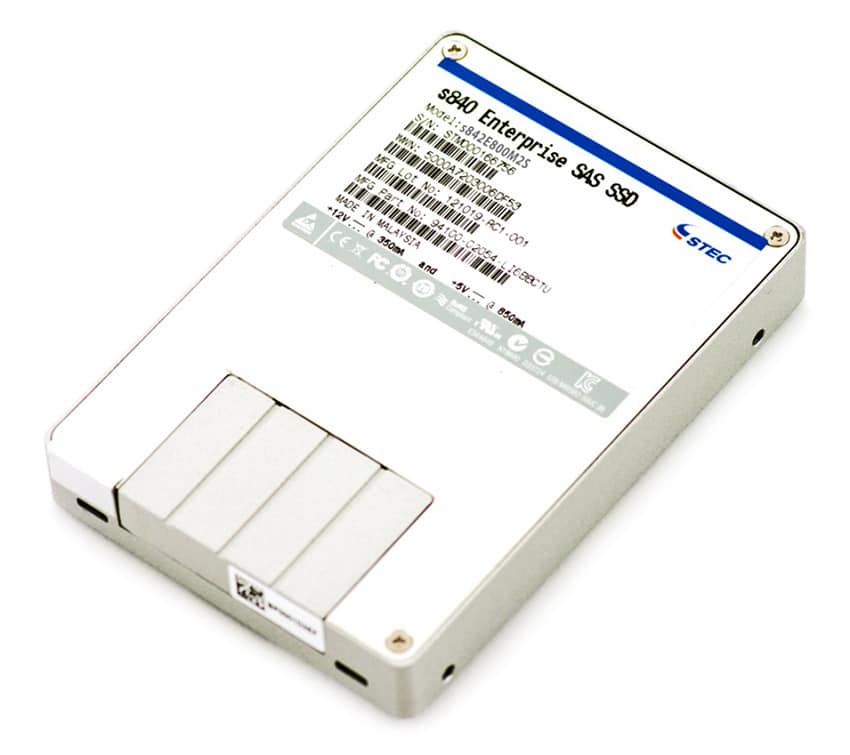
The pedigree and IP portfolio can’t be understated as we evaluate flash technologies. They’re the core differentiator in a market that has a tendency to be filled with substantial noise, imitators and commodity-based products. Just being around and serving military and specialty markets since 1994 isn’t good enough on its face though, there has to be more. STEC has more though, which is the core driver to the company’s value proposition and highlighted by the fact that they design and produce their own controller, which is a massive technical advantage. This advantage becomes stronger as manufacturers turn to use smaller geometry NAND sizes, where having a controller hardware and firmware that can cope with the NAND imperfections that get worse through each die change is very important.
Using MLC NAND in a high-performance enterprise SSD isn’t a foreign concept, but doing so means the vendor has to be able to understand and manage the NAND to drive the required endurance out of the drive. STEC calls their endurance technology Cell Care, which pairs with Advanced Flash Management to deliver on both the endurance claims and consistent and predictable steady state performance over the life of the SSD. STEC offers full data path protection to ensure security of in-flight data as well as PowerSafe, an on-board capacitor that prevents data loss in the event of power failure. The STEC implementation of the capacitors is also unique, as they’re in a module that can be field serviced in the event the capacitors ever need to be replaced without opening the case. Lastly in the tech-suite overview, STEC offers SAFE Technology, which is another security feature designed to protect data in the event of a die failure.
All of these technologies and the migration to MLC NAND mean the customer gets a pretty attractive TCO picture over the projected useful life of the drive. STEC quotes endurance figures of 10 full random drive writes per day, without the added cost of SLC-NAND that is generally required to hit those figures.
The STEC flash lineup has been rebalanced some lately, so it’s worthwhile to provide an overview of the current offerings to better understand where the drives fit in. As noted, the STEC s840 utilizes a dual-port SAS interface and is targeted at high-performance applications and database needs with heavy mixed-workload use profiles. STEC also offers the s620, which is an entry-enterprise SATA SSD that’s designed for largely read intensive uses. For a higher step up in performance, STEC sells a PCIe application accelerator, the s1100, designed for high IO applications, databases, caching and other duties. Last but not least, STEC has EnhanceIO SSD Cache Software, which is a flash independent caching software.
STEC s840 SSD Specifications
- Capacities
- 200GB – S840E200M2S
- 400GB – S840E400M2S
- 800GB – S842E800M2S
- Dual-port SAS interface
- Sector Size: 512b
- Toshiba MLC NAND
- STEC 24950-15555-XC1 Controller
- Performance
- Sustained Read Throughput: Up to 529MB/s
- Sustained Write Throughput: Up to 453MB/s
- Max 100% Read IOPS: Up to 118,000
- Max 100% Write IOPS: Up to 62,500
- Max 100% Random Read IOPS: 93,000 (8K)
- Max 100% Random Write IOPS: 19,500 (8K)
- Random 70% Read/30% Write IOPS: 37,800 (8K)
- Form Factor: 2.5-inch
- Power Consumption: 6.87W 100% Read
- Endurance: 10 full random drive writes per day
- Data Reliability: 1 unrecoverable error in 1017 bits read
- Dimensions: 100.2mm (L) x 69.8mm (W) x 15.0mm (H)
- Weight: <0.4 kg
- Operational Temperature: 0° to 60°C (Commercial)
- Warranty: 5 Years
Design and Build
The STEC s840 is a 15mm SSD with a SAS interface and 2.5" form factor. This taller z-height is frequently seen among high-performance and high capacity enterprise SSDs, with the exception of a few that are 9.5mm.
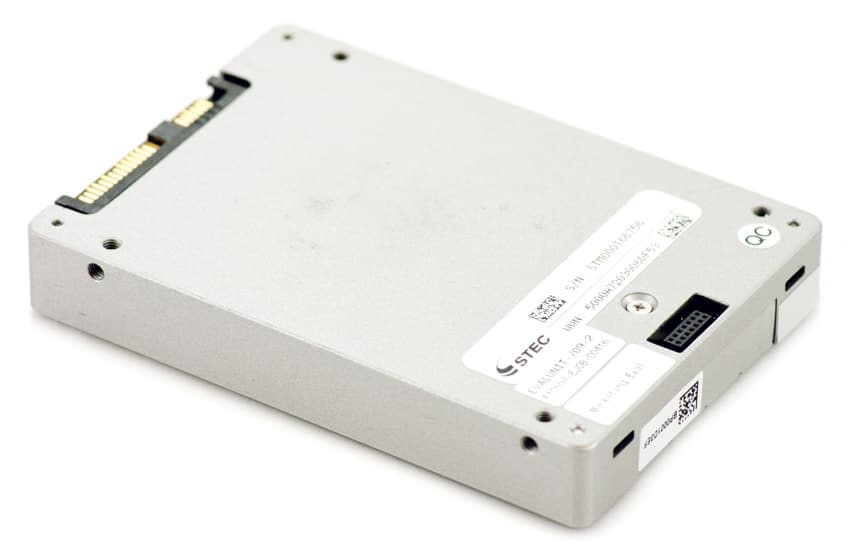
The interface on the STEC s840 is a dual-port SAS connection, commonly found on high-end enterprise SSDs. The advantage of SAS is that it offers built-in fail-over capabilities allowing high-availability installations as well as a wide-port mode that enhances performance in certain situations. SAS also offers a much higher I/O request queue, which can help reduce latency during intensive workloads.
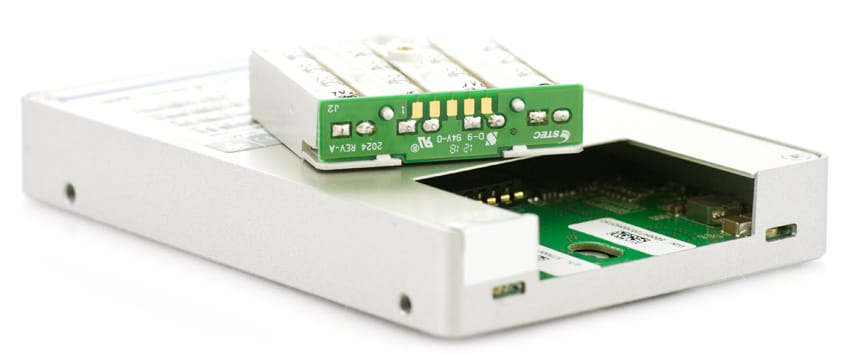
The case around the STEC s840 is metal alloy, with a unique feature that we have not seen on any other SSD. With the goal of making the s840 as serviceable as possible when installed in the field, STEC designed the power backup to be easily replaced without removing the top cover from the SSD. Users remove one screw from the bottom of the case and slide out the power pack for replacement. STEC told us that while the module is easy to fix once in service, they rarely find customers doing so because STEC designed it in a way that limits failures of the power module.
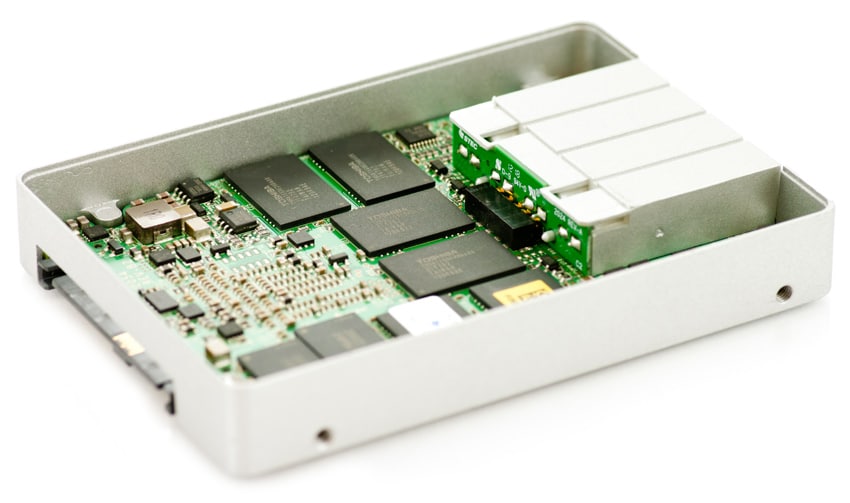
Removing the top cover from the STEC s840 we find the bottom-side of the circuit board, showing off the DRAM cache as well as the PowerSafe capacitor unit. This side of the SSD doesn’t include any thermal pad, which is instead sandwiched between the circuit board and the bottom of the case.
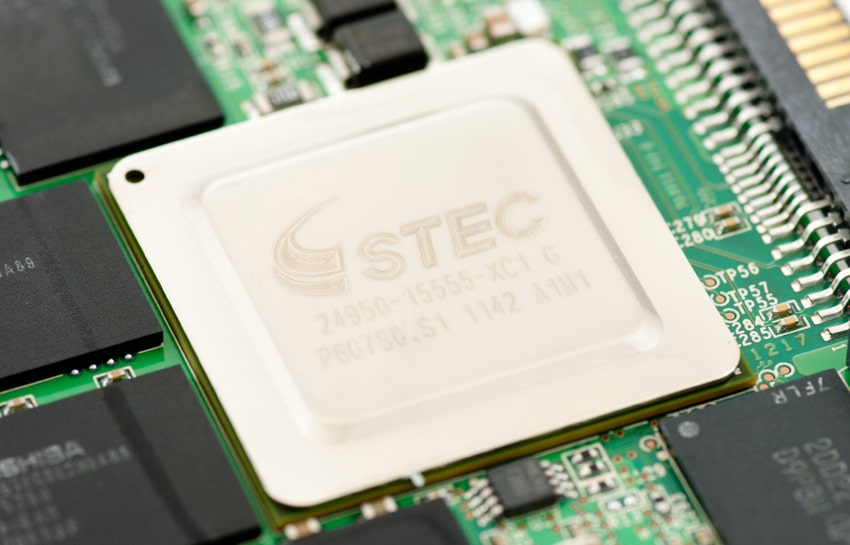
One of the significant advantages of the STEC s840 is the controller. STEC designed and coded the controller in-house, instead of sourcing it from a third party. This leads to a better integration among components and gives STEC advantages in terms of reliability and support as all the controller and software stack knowledge and IP resides in-house.
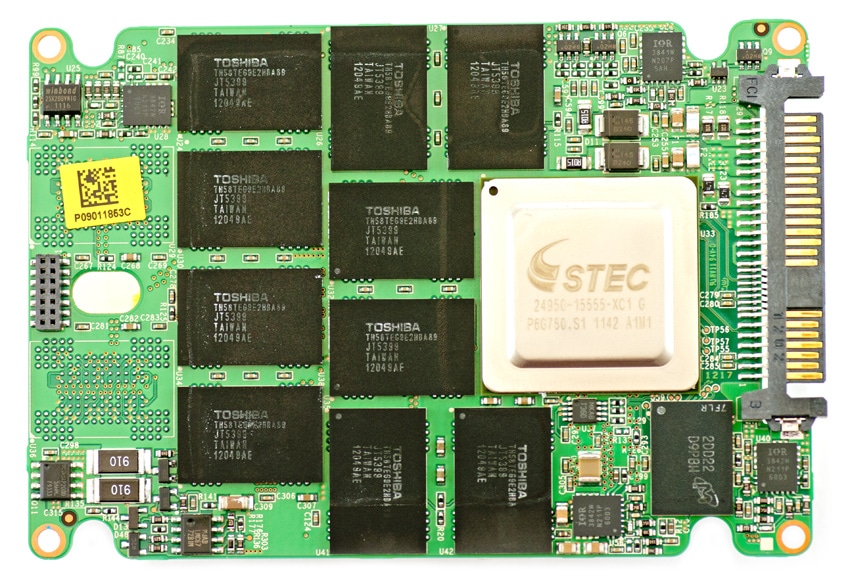
The top side of the STEC s840 circuit board includes ten Toshiba MLC NAND pieces, the STEC controller, as well as a piece of Micron DRAM. The 800GB model uses 64GB NAND pieces, giving it a total RAW capacity of 1TB and an over-provisioning level of 28%.
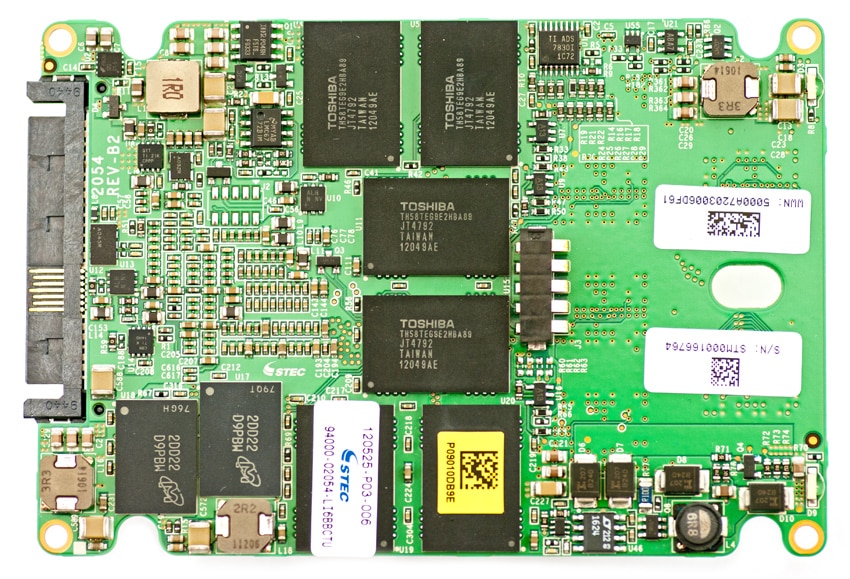
The bottom of the circuit board includes six Toshiba MLC NAND pieces, two additional pieces of Micron DRAM, and the PowerSafe connector.
Testing Background and Comparables
Our 800GB STEC s840 review drives use a STEC 24950-15555-XC1 controller and Toshiba MLC NAND with a SAS 6.0Gb/s interface. The comparables are listed below and include traditional SLC-based SAS performance drives as well as the SMART Optimus which is an MLC SAS offering with SLC-like performance and endurance.
Comparables for this review:
- Hitachi Ultrastar SSD400S.B (400GB, Intel EW29AA31AA1 controller, Intel 25nm SLC NAND, 6.0Gb/s SAS)
- SanDisk Lightning LB 406S (400GB, Pliant PTHEMI2-1VO controller, Micron 34nm SLC NAND, 6.0Gb/s SAS)
- SMART Optimus (400GB, Third-party controller, Toshiba MLC NAND, 6.0Gb/s SAS)
- Toshiba MKx001GRZB (400GB, Marvell 88SS9032 controller, Toshiba 32nm SLC NAND, 6.0Gb/s SAS)
All enterprise SSDs are benchmarked on our enterprise testing platform based on a Lenovo ThinkServer RD240. The ThinkServer RD240 is configured with:
- 2 x Intel Xeon X5650 (2.66GHz, 12MB Cache)
- Windows Server 2008 Standard Edition R2 SP1 64-Bit and CentOS 6.2 64-Bit
- Intel 5500+ ICH10R Chipset
- Memory – 8GB (2 x 4GB) 1333Mhz DDR3 Registered RDIMMs
- LSI 9211 SAS/SATA 6.0Gb/s HBA
Enterprise Synthetic Workload Analysis
Flash performance varies throughout the preconditioning phase of each storage device. Our enterprise storage benchmark process begins with an analysis of the way the drive performs during a thorough preconditioning phase. Each of the comparable drives are secure erased using the vendor’s tools, preconditioned into steady-state with the same workload the device will be tested with under a heavy load of 16 threads with an outstanding queue of 16 per thread, and then tested in set intervals in multiple thread/queue depth profiles to show performance under light and heavy usage.
Preconditioning and Primary Steady-State Tests:
- Throughput (Read+Write IOPS Aggregate)
- Average Latency (Read+Write Latency Averaged Together)
- Max Latency (Peak Read or Write Latency)
- Latency Standard Deviation (Read+Write Standard Deviation Averaged Together)
Our Enterprise Synthetic Workload Analysis includes four profiles based on real-world tasks. These profiles have been developed to make it easier to compare to our past benchmarks as well as widely-published values such as max 4K read and write speed and 8K 70/30, which is commonly used for enterprise drives. We also included two legacy mixed workloads, the traditional File Server and Webserver, each offering a wide mix of transfer sizes.
- 4K
- 100% Read or 100% Write
- 100% 4K
- 8K 70/30
- 70% Read, 30% Write
- 100% 8K
- File Server
- 80% Read, 20% Write
- 10% 512b, 5% 1k, 5% 2k, 60% 4k, 2% 8k, 4% 16k, 4% 32k, 10% 64k
- Webserver
- 100% Read
- 22% 512b, 15% 1k, 8% 2k, 23% 4k, 15% 8k, 2% 16k, 6% 32k, 7% 64k, 1% 128k, 1% 512k
In our first test we apply a 100% 4K random write pattern with a load of 16 threads and 16 queue. Looking at total throughput, the STEC s840 comes in towards the base of the pack with an average steady-state speed of around 16,000 IOPS write, which was reached about 60 minutes into the test.
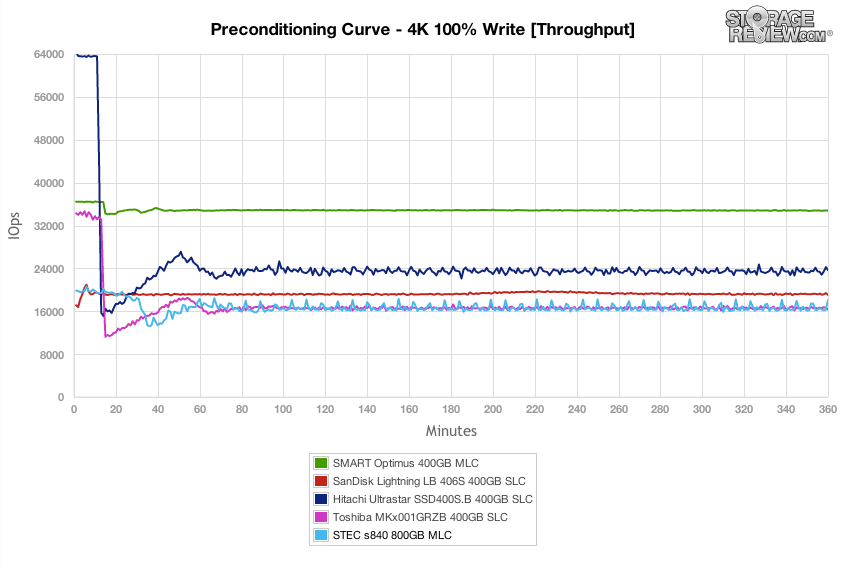
The STEC s840 leveled off with an average latency measuring 14-16ms once it reached steady-state, with one of the more interesting patterns out of the drives we’ve tested.
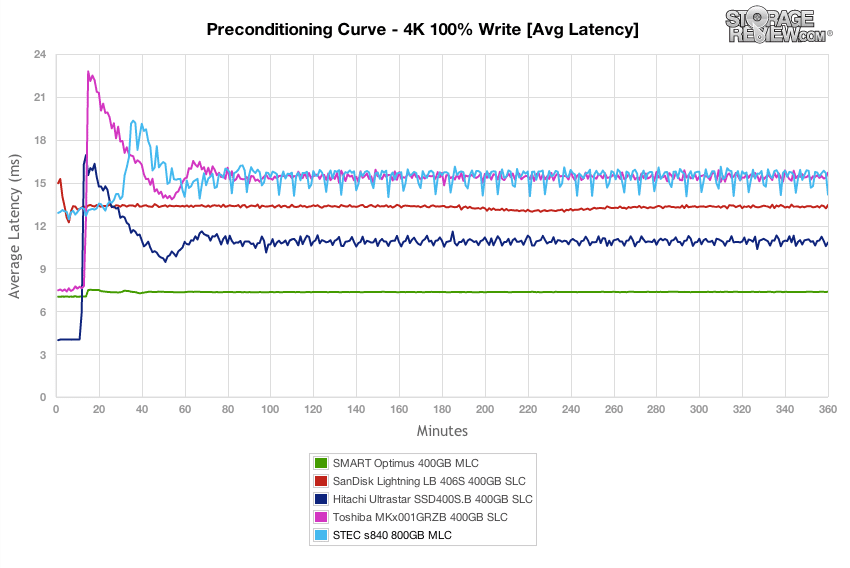
Even with its MLC-based design, the STEC s840 offered maximum response times lower than most of the drives in this category, staying below 100ms once it reached steady-state.
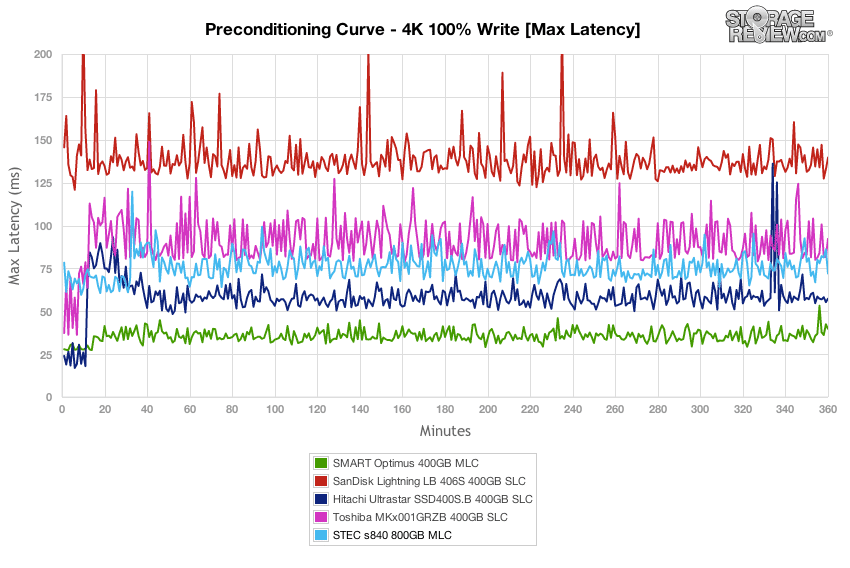
Further diving into the latency metrics during our 4K random write test, the latency standard deviation on the s840 scored very well toward the top of the pack.
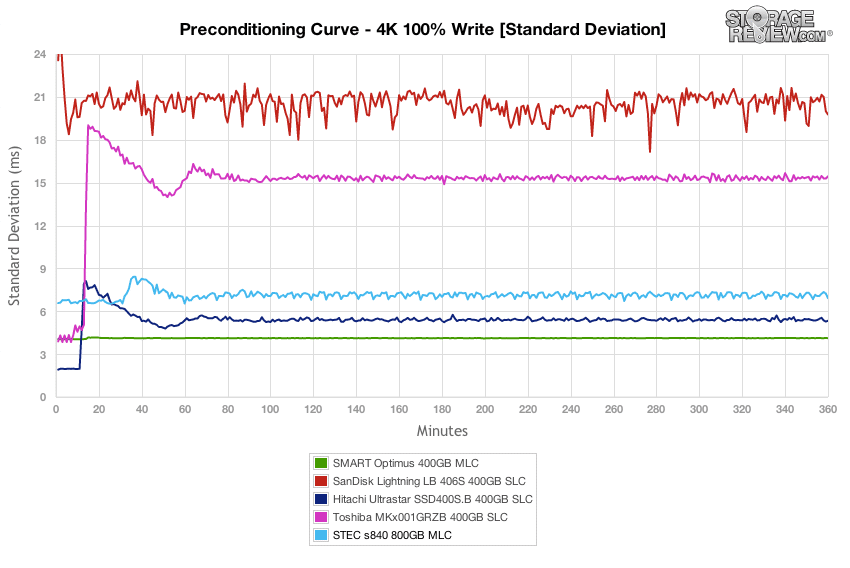
After finishing the preconditioning segment of our test we measured longer samples of both 100% 4K random read and write performance of the STEC s840. In single-port mode we measured peak 4K throughput of 86,171 IOPS read and 16,572 IOPS write.
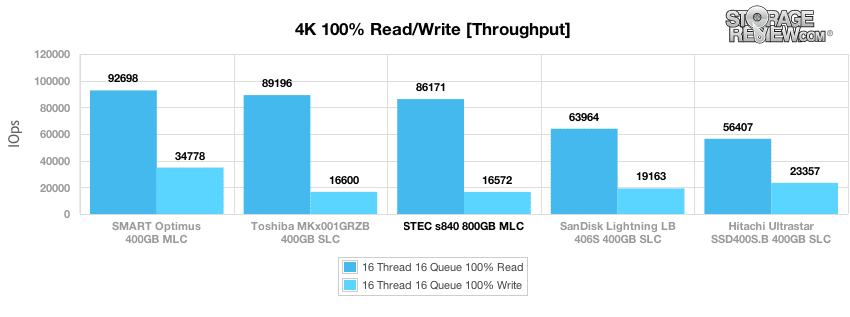
Average latency over the duration of our 4K read test measured 2.97ms while write latency measured 15.44ms with an effective queue depth of 256.
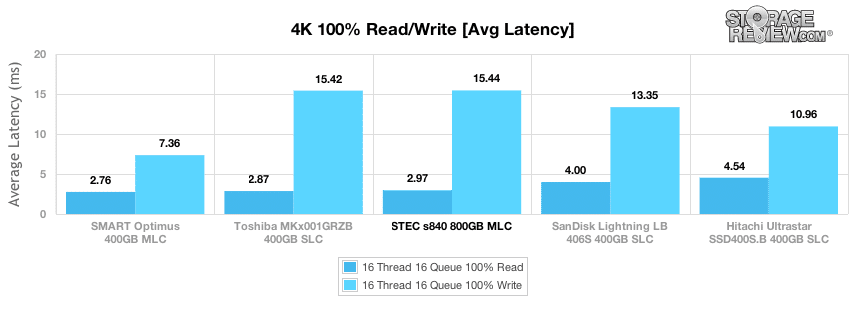
The STEC s840 had the lowest 4K read peak response time measuring 15ms, with a peak write latency of 97.7ms.
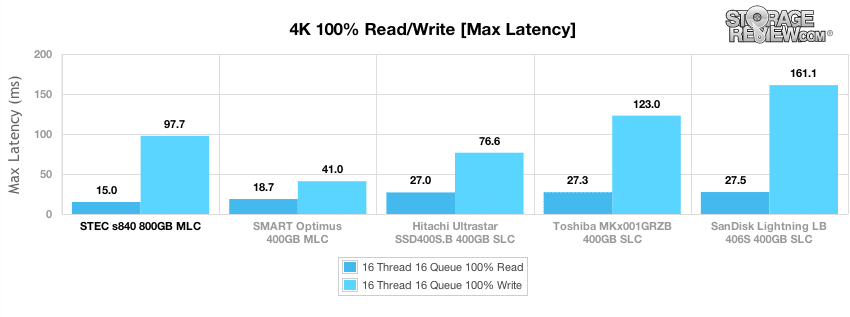
With consistent latency being key in enterprise SSDs, the STEC s840 came in toward the middle of the SLC-SSD pack in both read and write latency standard deviation.
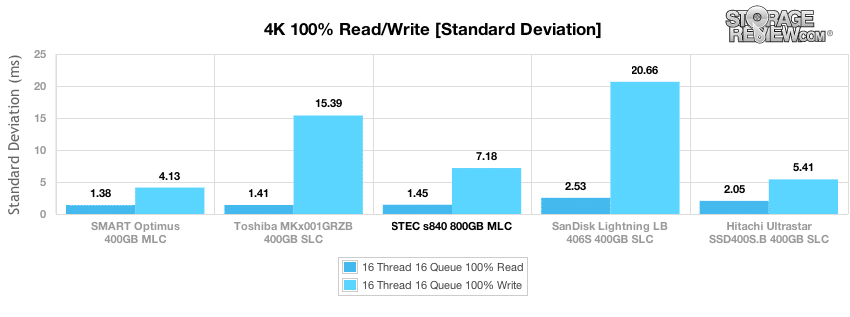
In our first mixed workload using an 8K profile 70/30% read/write spread, the STEC s840 came in second place behind the SMART Optimus. After reaching steady-state around 80 minutes in, performance measured between 37,000-42,000 IOPS.
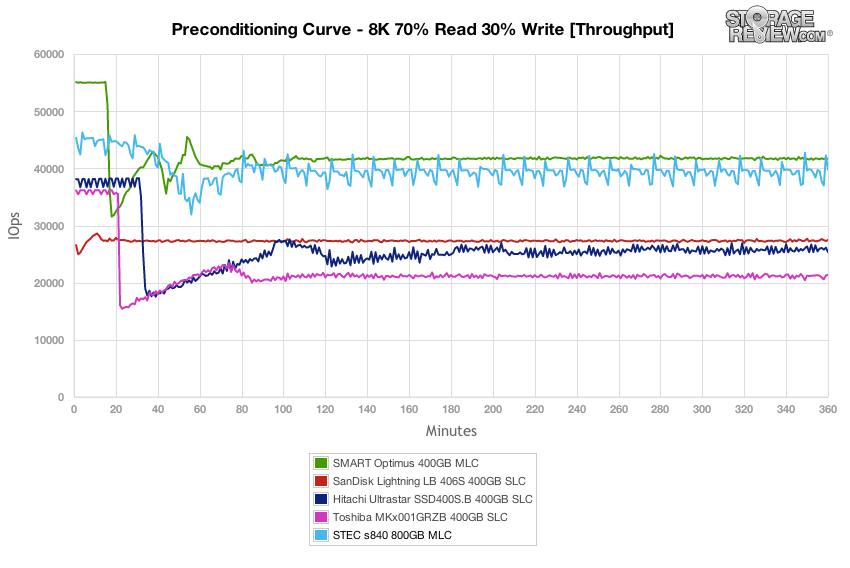
With an effective queue depth of 256, the STEC s840 kept average latency in check, with response times measuring just under 7ms.
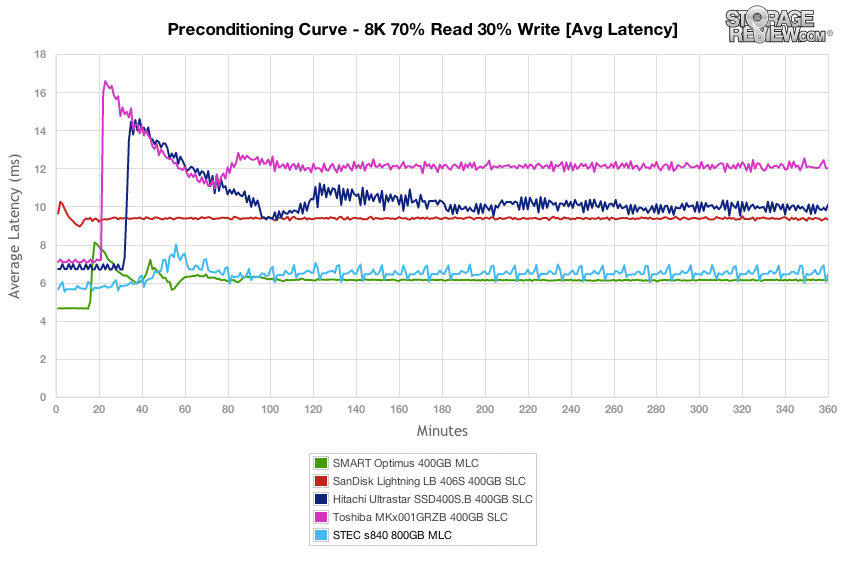
Switching to peak response times, the MLC-based STEC s840 kept its max times below 50ms once it reached steady state.
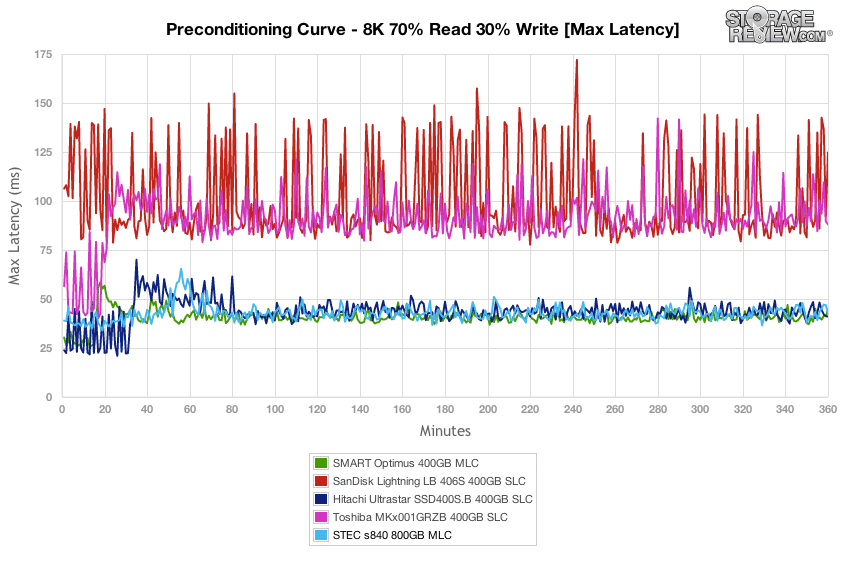
Drilling down into latency standard deviation, the STEC s840 offered best-in-class latency with the most consistent performance out of the group in our 8K 70/30 preconditioning segment.
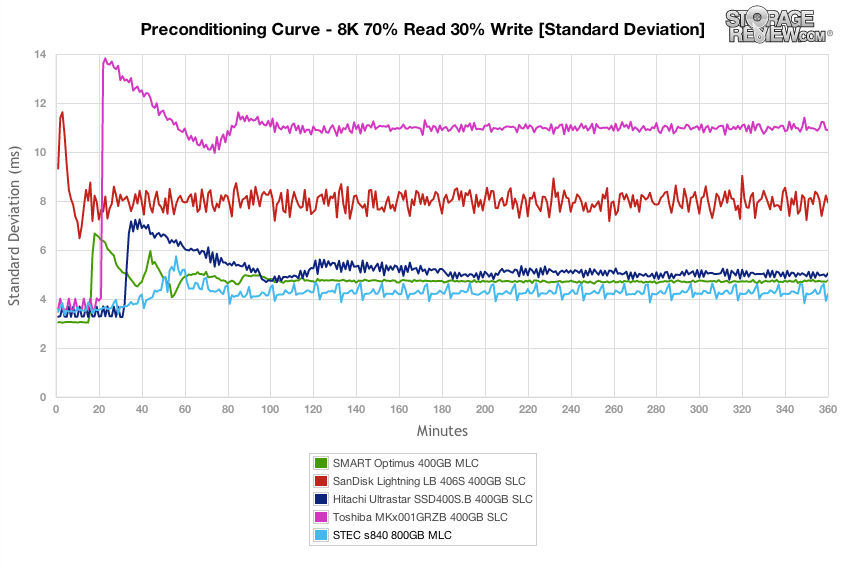
Compared to the fixed 16 thread, 16 queue max workload we performed in the 100% 4K write test, our mixed workload profiles scale the performance across a wide range of thread/queue combinations. In these tests we span workload intensity from 2 threads and 2 queue up to 16 threads and 16 queue. In the expanded 8K 70/30 test, the STEC s840 showed incredibly strong performance in the bulk of the load ranges; only being surpassed at the highest effective queue depths. With most activity in enterprise conditions happening below full saturation, the STEC s840 would most likely show the greatest performance in a normal production environment with 8K workloads.
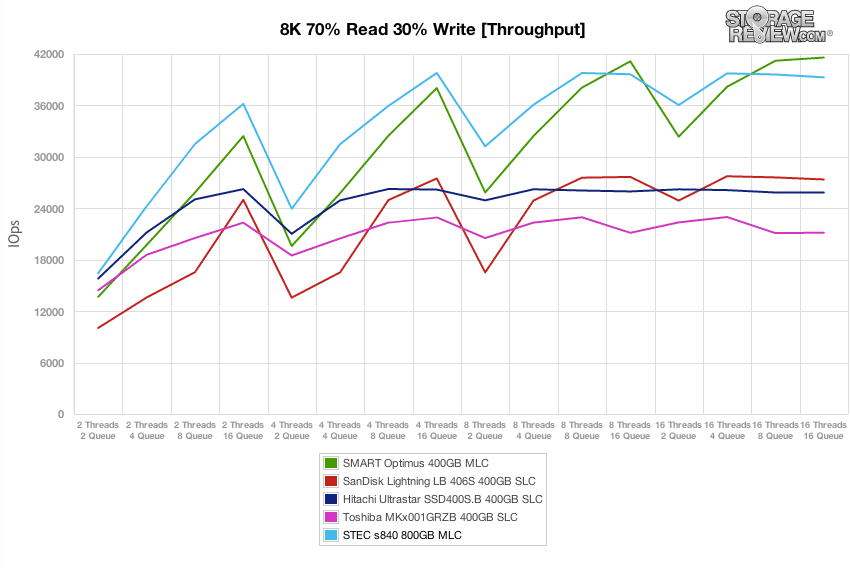
The STEC s840 has no trouble offering the fastest average latency most of the 8K 70/30 test, only being surpassed by the SMART Optimus at the highest effective queue depth levels.
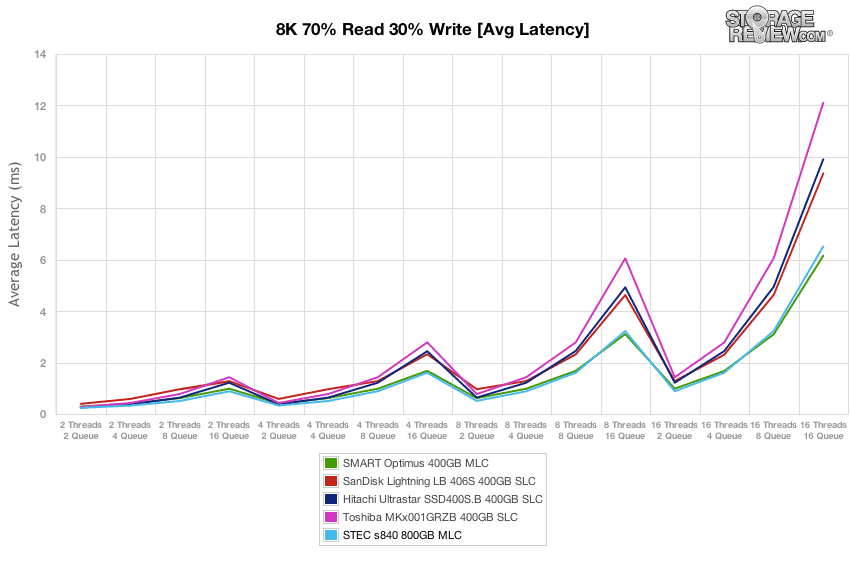
Comparing peak response times over the wide range of loads from an effective queue depth of 4 to 256, the STEC s840 comes in toward the top of the pack with the lowest times. The s840 stayed under 50ms for entire test, with the bulk of that under 40ms.
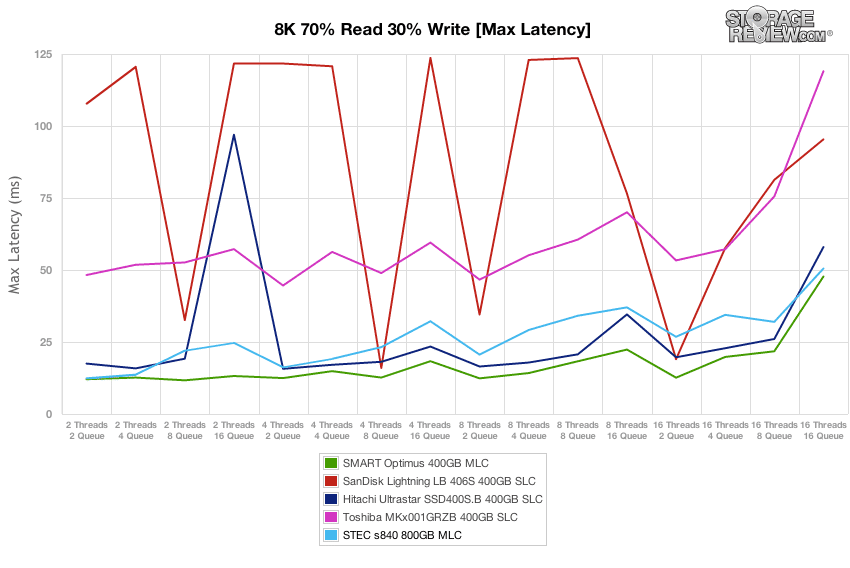
The latency standard deviation in our 8K 70/30 test stayed consistent over the entire spread of queue depths, being surpassed only by a small margin from the Hitachi SSD400S.B.
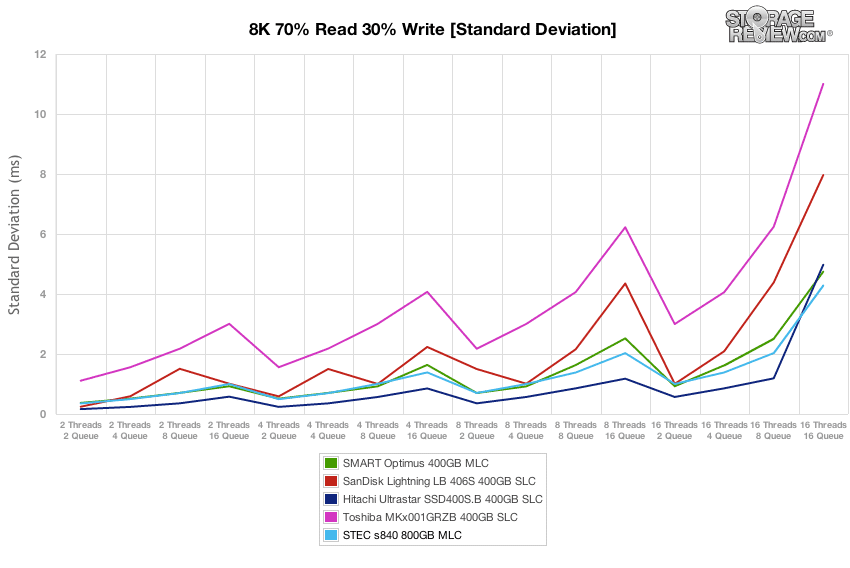
The next workload is our File Server profile, which covers a wide range of transfer sizes spanning from 512b to 512K. In this section the STEC s840 still maintains its spot toward the top of the pack, alongside the SMART Optimus and SanDisk Lightning.
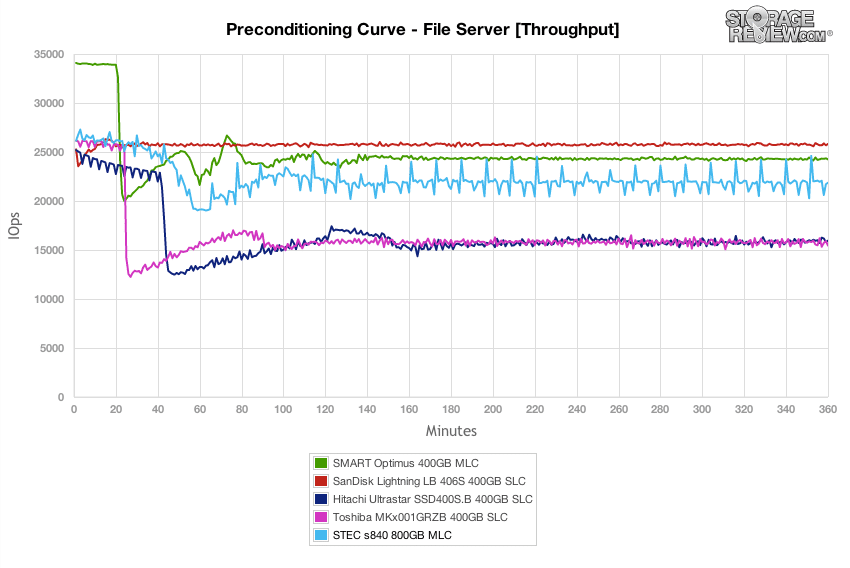
After reaching steady-state 100-120 minutes into the preconditioning stage, the STEC s840 averaged a 11-13ms response time over the remaining portion of the test.
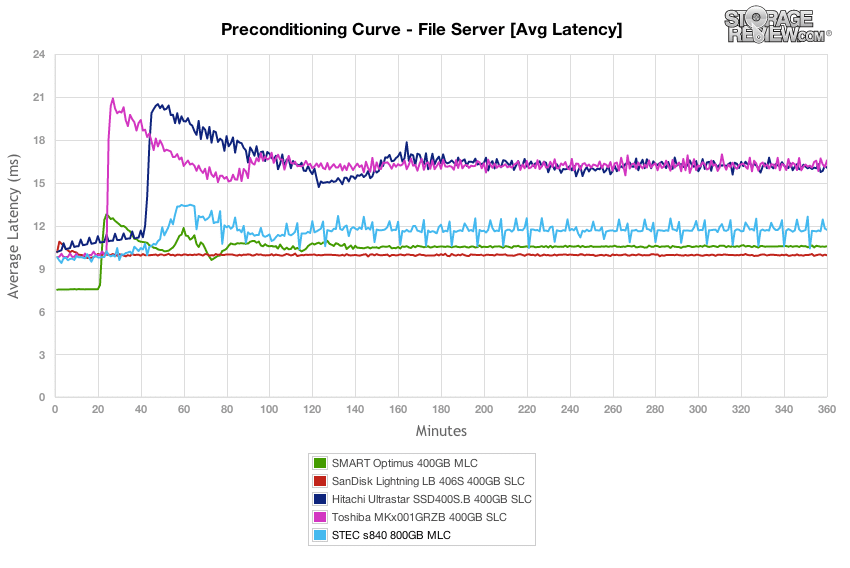
Comparing max latency in the File Server preconditioning test gets slightly confusing, with each SSD measuring 50ms of one another. Looking at the STEC s840’s performance though, it came in with one of the lower peak response times in each interval, measuring just over 75ms. The best in this category measured around 60ms, with the worst around 150ms or above.
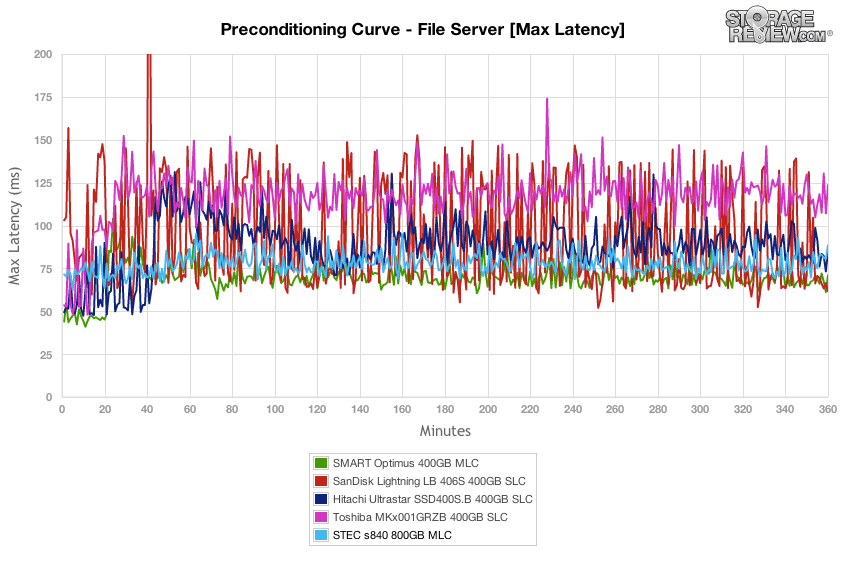
Comparing the latency standard deviation in the preconditioning phase of our File Server test, the STEC s840 nearly matched the SMART Optimus, which both rank second compared to the SanDisk Lightning.
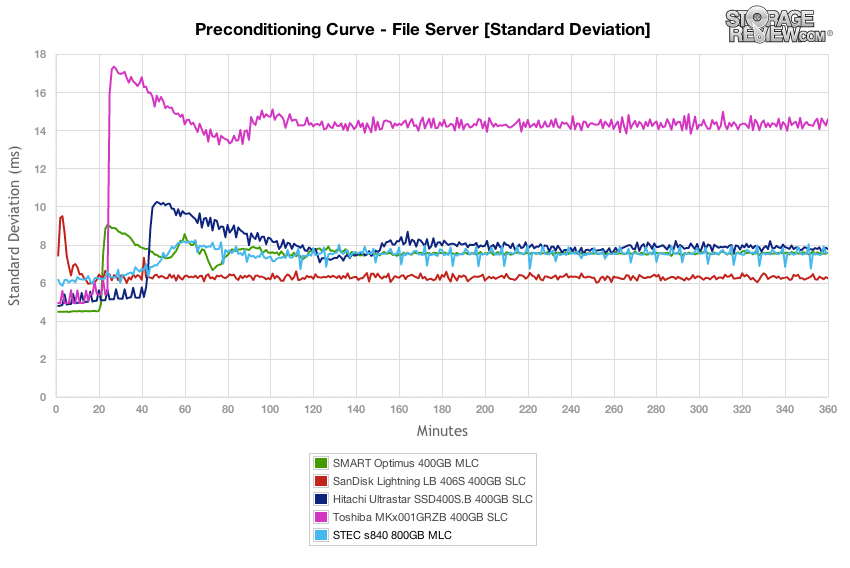
After we completed the preconditioning phase of our File Server test, we measured the performance of each SSD at a load between 2T/2Q and 16T/16Q. Similar to the speed we noticed in the 8K 70/30 test, the STEC s840 offered the highest performance in this class at the lowest effective queue depths. As the queue depth peaked in each segment, it was surpassed by the SanDisk Lightning, but still ranked at the top of the class in overall performance.
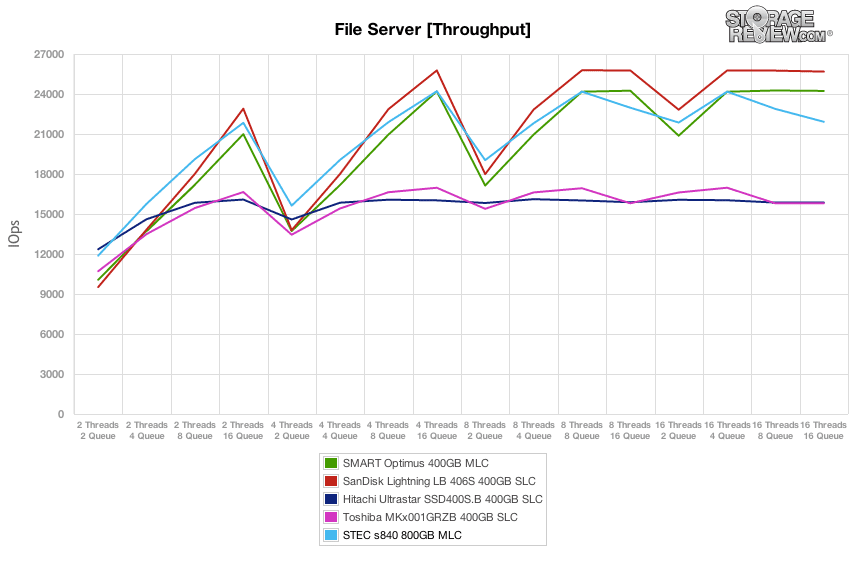
Switching to a look at average latency, the STEC s840 performed neck and neck with both the SMART Optimus and SanDisk Lightning.
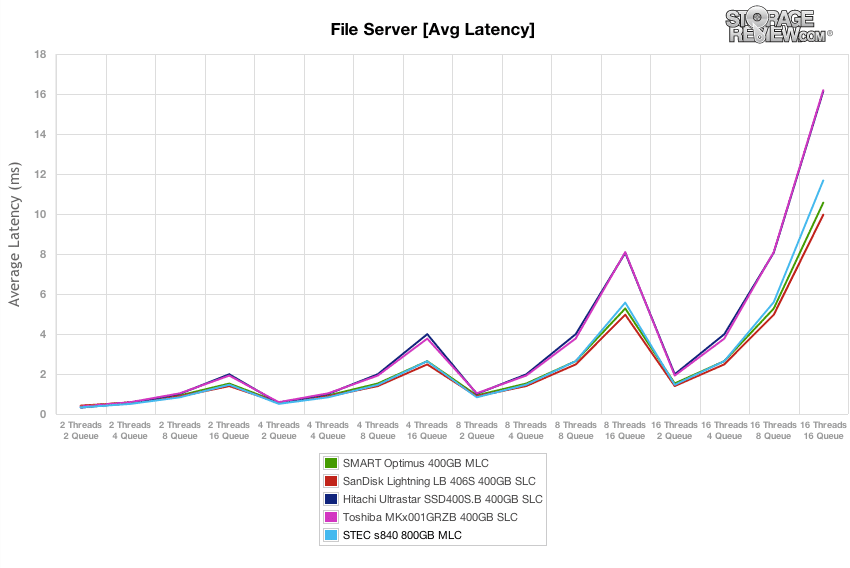
Over each load in our File Server test, the STEC s840 came in at the middle of the pack over the range of effective queue depths, with max response times staying below 50ms for most loads, increasing to just below 100ms at the highest queue depths.
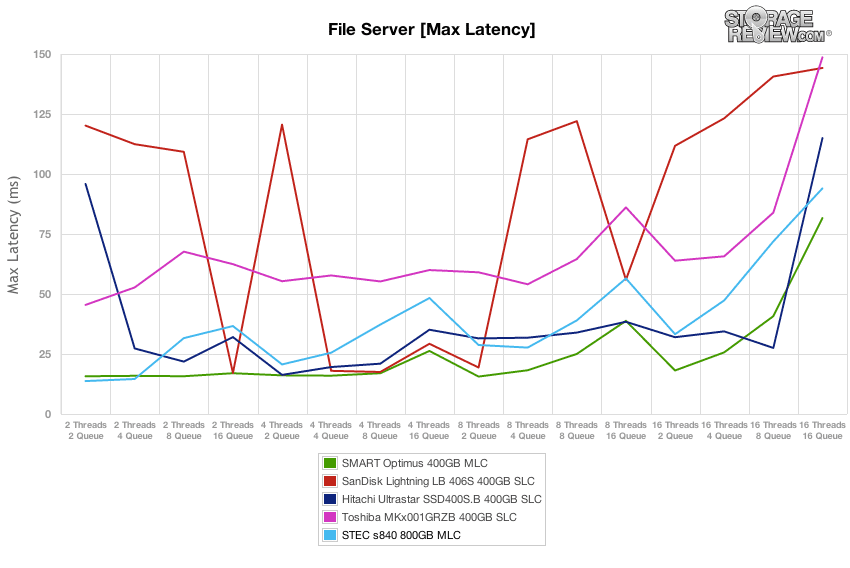
With the large spread of transfer sizes, each SSD is working harder to maintain performance. In this test, the STEC s840 performed with the fastest SLC-based SSDs and kept latency more consistent than the SMART Optimus which also uses MLC NAND in its high-performance configuration.
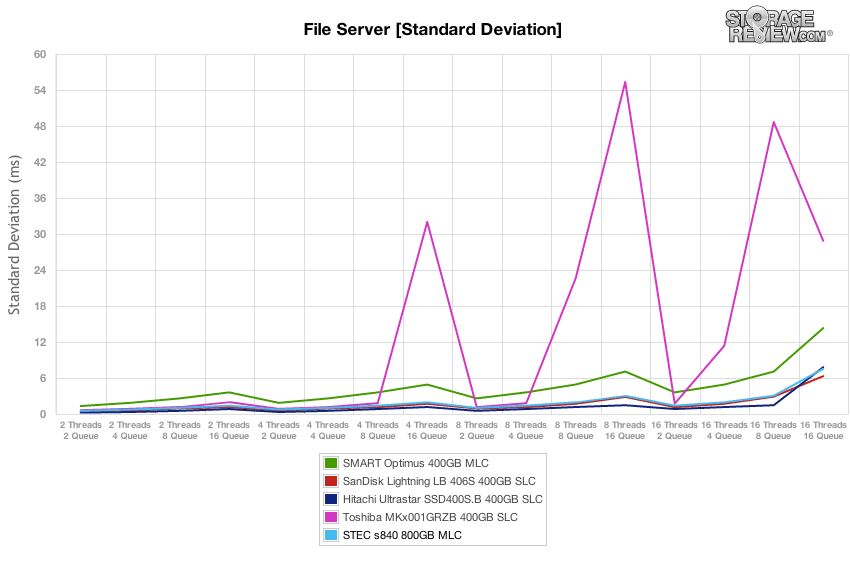
Our final preconditioning workload takes the traditionally 100% read activity Web Server test and flips it to 100% write to precondition each SSD. In this segment the SanDisk Lightning LB 406S had high throughput with the other comparables, including the s840 coming in with much lower performance.
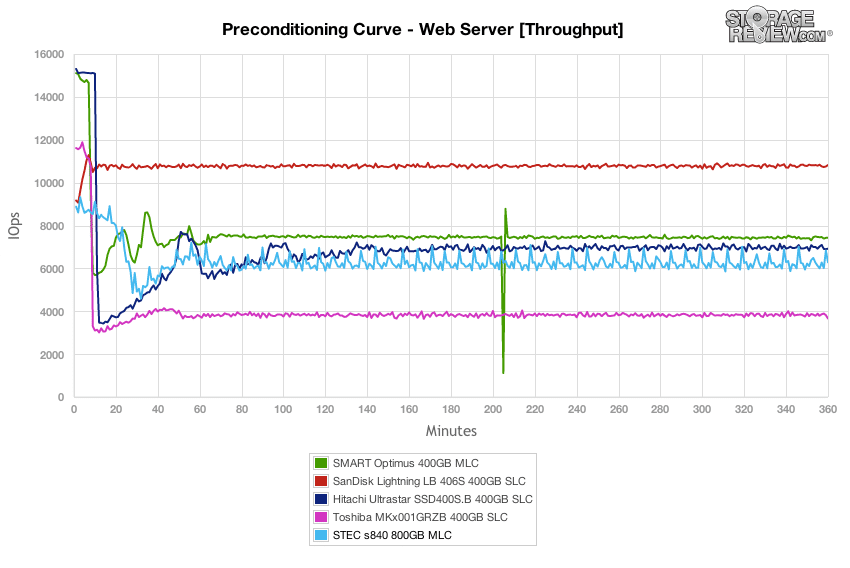
With the 100% write preconditioning workload at an effective queue depth of 256, the STEC s840 maintained an average latency of around 40ms once it reached steady-state.
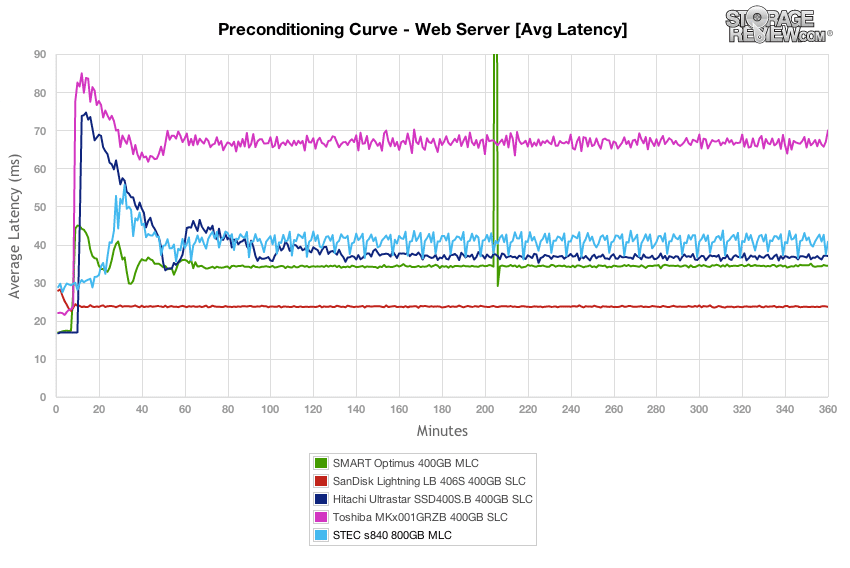
Over the entire preconditioning process in our Web Server workload, the STEC s840 kept its max response times between 150-200ms, which is in the same range as many of the top-performing SLC-based SSDs.
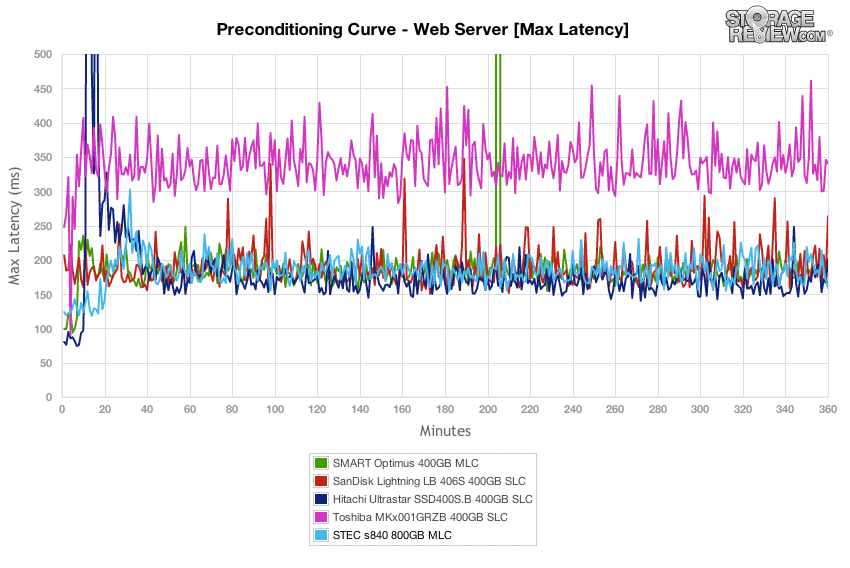
Switching our focus from peak latency to overall latency consistency, the STEC s840 offered the lowest standard deviation in the Web Server preconditioning test.
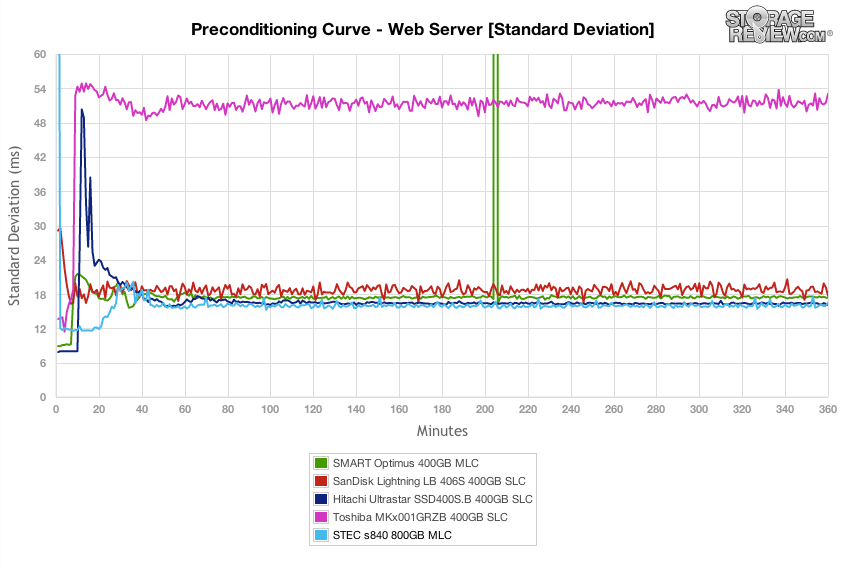
For the remainder of our Web Server test, we switch back to 100% read activity (whereas the preconditioning was 100% write). In this test, the STEC s840 again offered the highest performance in the group at the lower effective queue depth ranges, only being out-paced at the highest levels.
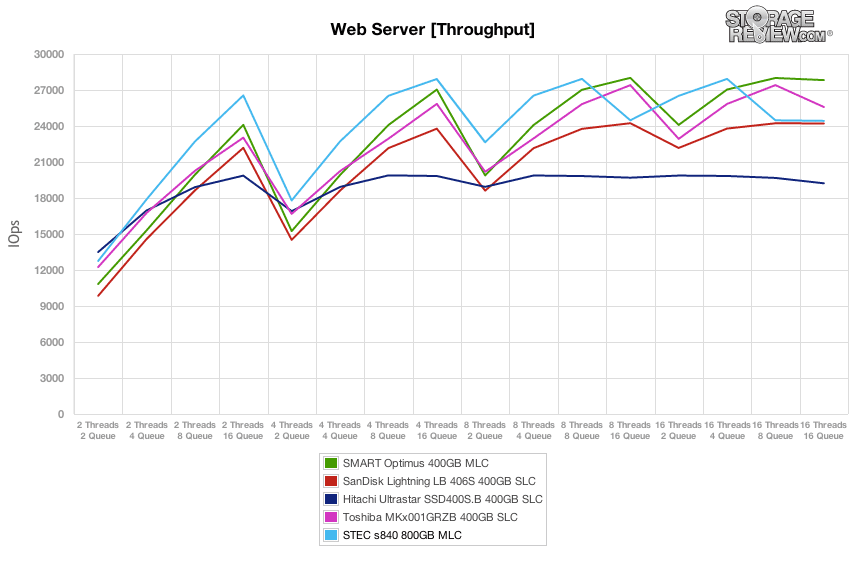
Average latency in our Web Server profile run on the STEC s840 showed it offered a small lead over the comparable SLC-class enterprise SSDs in all but the highest effective queue depth levels.
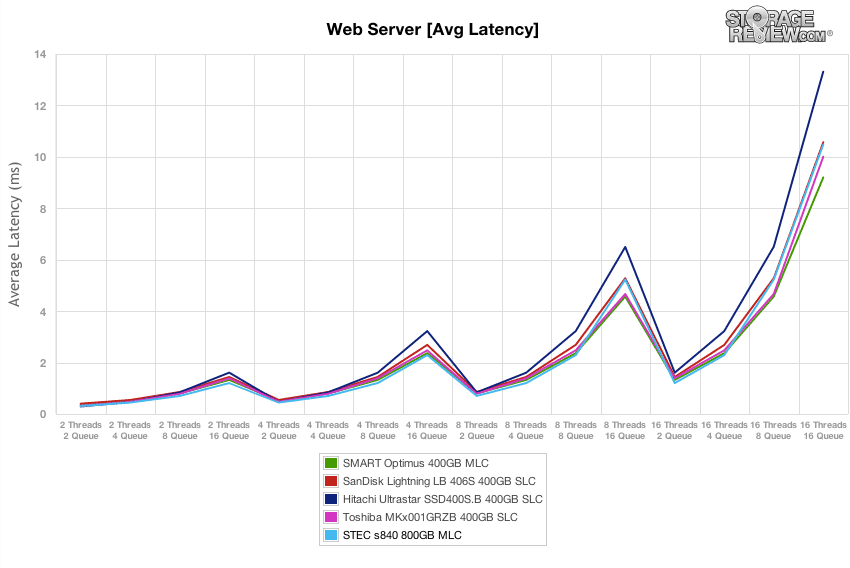
Peak response times in the 100% read section of the Web Server test from the STEC s840 measured under 50ms over the all but the highest workload. It performed at the top of its class, ranking neck and neck with the Hitachi SSD400S.B.
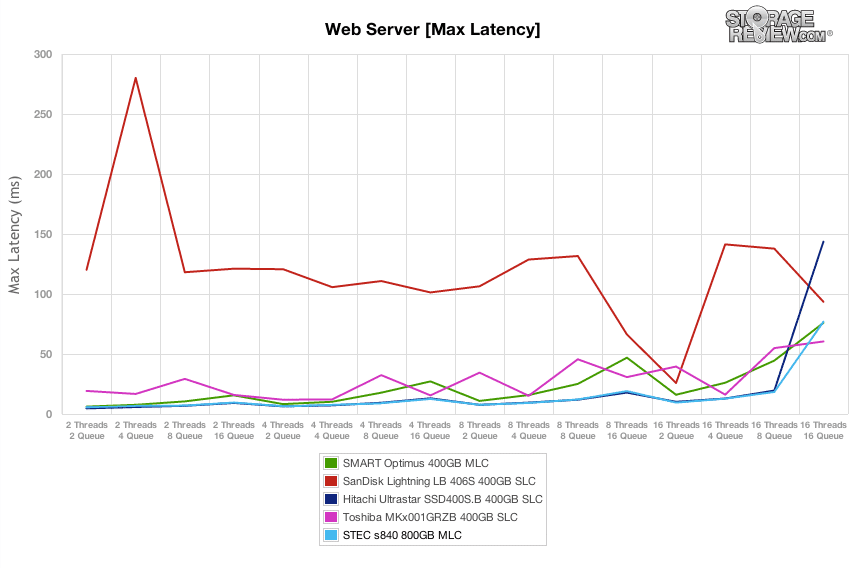
Taking a closer look at the latency in our standard deviation section of the Web Server test showed the STEC s840 edging out with the lead in most areas, except the highest effective queue depth.
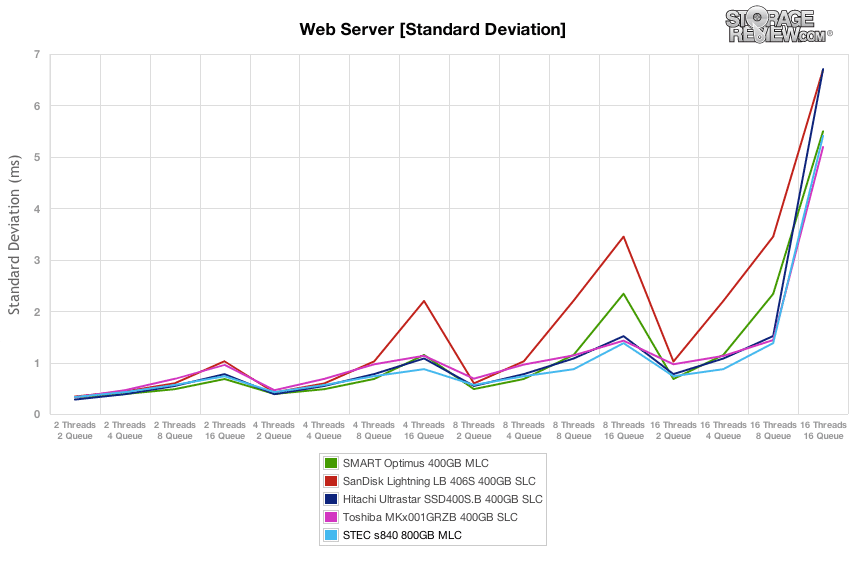
Conclusion
The STEC s840 SSD firmly targets the mainstream and performance enterprise markets, but offers a better value-proposition than the leading SLC NAND alternatives. By leveraging MLC NAND and owning their own controller, STEC is able to drive both drive performance and endurance, while being able to offer an impressive value proposition. STEC also has a support and engineering advantage by using an in-house controller and the overall package is further bolstered by a robust IP portfolio spanning nearly 20 years in the flash storage business.
As we saw in our performance results, the s840 does very well across the board, even compared to mostly SLC-based drives. The drive did especially well in mixed workloads, where it offered a significant advantage at lower effective queue depths, where other drives needed more outstanding requests to reach peak performance. Even leveraging MLC NAND, STEC was able to reign in peak response times and maintain an excellent latency standard deviation which many times rivaled that of its SLC-based competitors. These strengths were most noticeable in workloads with a large spread of transfer sizes; such as our Web Server and File Server profiles.
STEC is the second manufacturer in recent months to offer an MLC-based drive that offers high-performance and high-endurance in a space filled with SLC-based products. As enterprise buyers continue to look for ways to cut costs, manufacturers that can leverage extensive IP in the SSD space to offer products that continue to push the performance envelope while lowering costs will have a leg up in this market.
Pros
- Highest performance across a wide range of thread/queue levels in many of our mixed workloads
- Low max latency and great latency standard deviation in all workloads
- Leverages in-house controller to drive SLC-like performance and endurance from MLC NAND
Cons
- Not offered in density maximizing 9.5mm form-factor
Bottom Line
The STEC s840 6Gb/s SAS enterprise SSD offers industry leading performance in many of our workloads in real-world conditions; at thread and queue levels below full saturation. Even with its high I/O performance, it still maintains exceptionally low peak latency at high effective queue depths with very low standard deviation, showing the strength of an SLC-based SSD even with commodity NAND.




 Amazon
Amazon